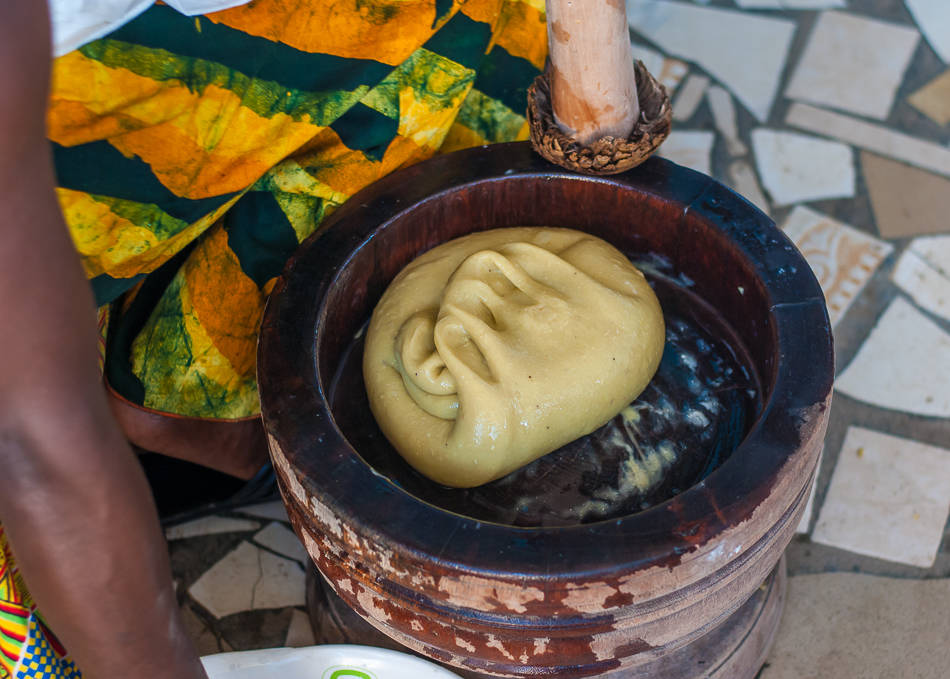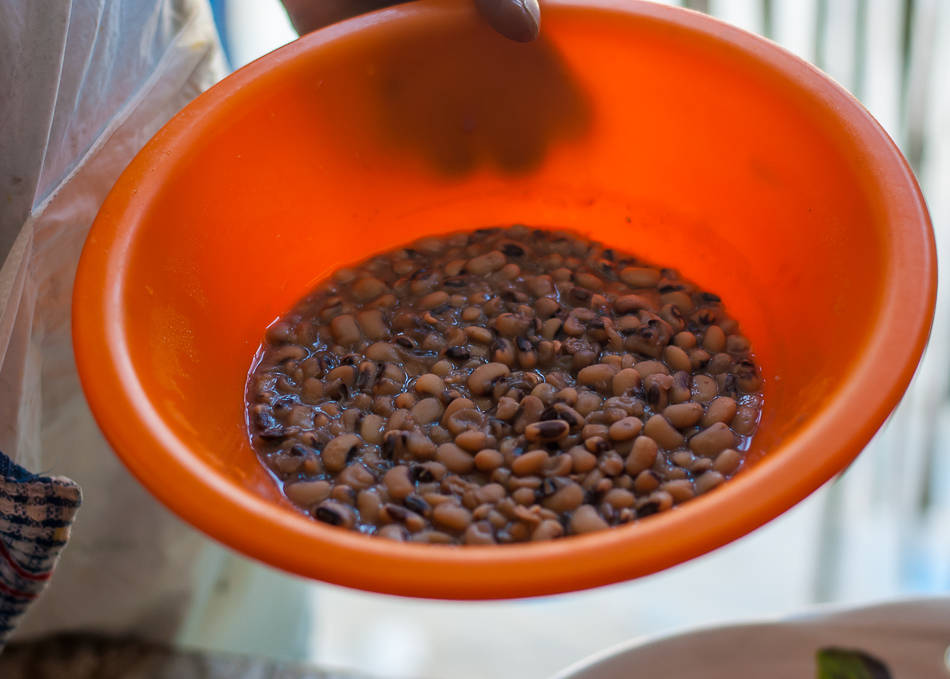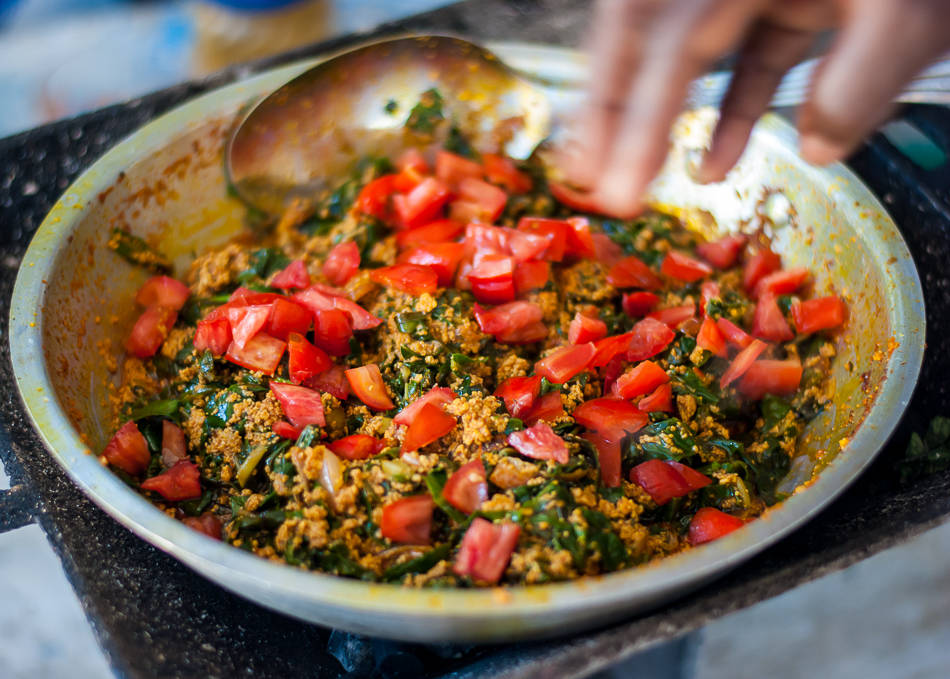Food is central to Ghanaian life as it is in any culture and while you could get by visiting the country with eating fairly westernized versions of kebabs, chips, and pasta dishes, you’d be greatly missing out. I didn’t know much about the food of Ghana before heading out apart from its notorious spiciness which was slightly scaring me as I usually have a hard time handling the heat. I did get my share of tears-inducing dishes but now that I’ve been here for a few months, I honestly couldn’t go without that addictive spicy and fishy hot black pepper sauce (called Shito) which seems to complement so well everything they eat here.
I quickly jumped into the local specialties and always laugh at the surprised looks I get from Ghanaians here, unused to seeing an obruni (white person) eat their street staples and loving it! The ubiquitous ‘chop bars’ found on every street corners are the place to indulge and I’ve illustrated below some of the main dishes you’ll find there with their recipes. Mind you, there aren’t many African cookbooks and most Ghanaians eyeball everything, knowing when it’s exactly to their taste so the instructions below are highly flexible! I took a cooking workshop to see and participate in the making of Red Red, Palava Sauce, Light Soup, Fufu, and Groundnut Soup.
Most dishes in Ghana contains a variation of the same staple ingredients:
Plantains (both ripe and green), cassava and yams makes up the starchy base for most dishes.

The other main ingredients consist of tomatoes, onions, garlic, ginger, small yellow eggplants (called garden eggs here), tomato paste, shrimp bouillon cubes from Maggi brand, salt, and a version of hot pepper paste or sauce made from fresh and fiery peppers.

Cooking mostly happens over a traditional charcoal stove though in big cities more and more people have access to a familiar sight: gas stove!

Now let’s get cooking!
Red Red
First-time visitors to Ghana are often introduced to Ghanaian cuisine with this dish, probably the most popular with foreigners. Red Red is a scrumptious bean stew served with fried plantains and gets its name from the palm oil (red) in which it is cooked. Without the palm oil, it cannot be called Red Red and would simply be a ‘bean stew with fried plantains’ or I’ve even heard Brown-Brown (somehow less appetizing!).
- 1 cup beans that have been soaked overnight (preferably black-eyed peas)
- ½ bottle palm oil (if you can’t find palm oil, you can substitute any type of vegetable oil or coconut oil, you just won’t be able to call this dish ‘Red Red’!)
- 2 small white onions
- 1 small can of tomato paste
- 1 teaspoon of Hot Pepper Sauce or cayenne pepper
- 1 teaspoon curry powder
- 5 ripe plantains (or green bananas)
- 1 shrimp or seafood bouillon cube (like Maggi)
- 1 garlic clove, finely chopped
- 1 teaspoon finely chopped fresh ginger
- Salt to taste
Fried Plantains Preparation:
Put oil in a pan over fire.

Remove plantain skins with a knife and slice them into ½” to ¾” pieces diagonally. When oil is hot, wash the plantain and put it in it.
Remove and cover plantains as they are finished – soft and slightly browned.
Bean Stew (red red) Preparation:
Boil the beans until soft (or soak overnight).
Using the same oil as the one you fried the plantains in, reheat and add the chopped onions into the pan, stirring until slightly browned. Add tin tomatoes, mashed garlic, chopped ginger, curry, salt and powder pepper (or fresh pepper paste) to mixture and stir for 5-10 minutes. You can also use a mortar and pestle to puree the ingredients before adding them to the pan.

Add beans and continue stirring for a few minutes.
Keep warm on low heat.
Presentation:
Place an equal portion of bean stew and plantains on each plate, and trust me when I say this is definitely a case of ‘it tastes a whole lot better than it looks’!
Palava Sauce & Boiled Yam
Palava (or Palaver) sauce is a traditional West African greens stew made with palm oil, tomatoes, and hot peppers, thickened with pumpkin seeds and flavored with dried, smoked fish. It soon became one of my go-to dishes here as I always felt I was missing on vegetables, Ghanaian cuisine being so starch heavy. It’s essentially a thick spinach sauce with loads of flavors and best eaten with boiled yam, rice, plantains or any types of root vegetables.
- 1 bundle of Nkontomire (you can substitute collard greens or spinach)
- 4 small red onions
- 1 tube yam (substitute about 4 large potatoes)
- 2 small cans tomato paste
- 2 medium tomatoes, chopped
- ½ bottle palm oil (substitute vegetable or coconut oil)
- 1 teaspoon hot pepper (cayenne pepper)
- Pinch of salt
- 1 shrimp bouillon cube (like Maggi)
- 1 cup ground pumpkin or melon seeds
- *optional: salted or smoked fish
Palava Sauce Preparation:
Put saucepan on the fire and add the red oil.
Chop onions and add to the oil.
Add pepper to the saucepan when the onions are browned.
Blend, chop, or grind tomatoes and salt and add to the saucepan.
Simmer for about 5 minutes.
Cut smoked fish (if using) into sizeable chunks and add to the saucepan.
Add a bit of water to the Angushi (ground pumpkin seeds) and the shrimp bouillon cube.
Mix well and deposit the mixture in spoonfuls into the saucepan.

Stir until it is well cooked – approximately 5 minutes.

Wash, thinly slice, and add Nkontomire into saucepan.

Add about half a glass of water to the saucepan and stir for approximately 5-10 minutes on low fire before adding the chopped tomatoes. Slowly cook for a few more minutes and keep warm.
Boiled Yam Preparation:
Heat water with a pinch of salt.
Wash and peel the yam. Slice into pieces ½ inch thick.
Wash yam pieces and place into the water.
Let the yam boil until it is soft then drain well.
Presentation:
Serve an equal portion of boiled yam and Palava sauce.
Light soup
While Red Red and Palava Sauce are fairly popular with locals and even more with foreigners, the most common Ghanaian dish is a soup eaten with either banku, fufu, or kenkey and a protein. Light soup is essentially the base of all types of soups found in Ghana and from it you can easily make Groundnut Soup (see below) and Palm Nut Soup.
It’s mainly a tomato-based soup with various vegetables added (pureed) and hot peppers which can make it pretty spicy, depending on who makes it. You’ll probably never taste two identical light soups and that’s OK though you’ll also find that the best ones are the ones done at home, not mass-produced in restaurants or roadside joints.
- 4 small eggplants
- 6 small tomatoes
- 4 small white onions
- About 1.5 lb pieces of meat with bones (chicken, beef or goat)
- 1 tablespoon minced garlic
- 1 teaspoon Hot Pepper paste or cayenne pepper
- 2 shrimp bouillon cubes (Maggi)
- *Optional: a few pieces of smoked fish
Light Soup Preparation:
Wash fish/meat and put in a saucepan. Add garlic, pepper, bouillon and a small amount of water (approximately ½ cup) and let steam for 10 minutes.

Meanwhile, wash and chop onions, garden eggs (small eggplants) and tomatoes and boil together.
Put the garden eggs, tomatoes, and onion into a blender and mix into a puree.
Add 2 cups of water to the saucepan (with the fish/meat), then add the puree.

Cook until there is not a lot of water and you see oil on the surface. Taste the soup, and add any spices you would like (such as salt) to taste while it is still on the fire.
Serve with fufu, banku, or kenkey.
Fufu
Fufu is every Ghanaian’s favorite dish and the true staple of Ghanaian cuisine. What can only be described as a gooey ball of mashed cassava or yam and plantain is surprisingly tasty and almost always served submerged in a soup. Walking anywhere in Ghana you’re likely to see women outside pounding heavily in a giant wooden mortar and pestle in the most hypnotic rhythm…well they’re making fufu, and it’s quite an extraordinary exercise to witness!
Eating fufu is clearly not as straightforward as eating red red or palava sauce and requires a bit of practice, which makes it even more fun. I can’t think of a better way to immerse yourself into Ghanaian culture than by eating fufu at a street stall, sharing a table with hungry locals. First of all you can only eat with your right hand (no spoon, and it’s a soup!) and the other surprising thing is that you’re not supposed to chew the fufu…only meant to swallow it which I admit I had a bit of trouble with at first.
- 4 cassava (you can substitute potatoes but the consistency will be quite different)
- 2 green plantains (or green bananas)
Fufu Preparation:
Boil a pot of water.
Wash and cut cassava into chunks and plantains into pieces.

Boil cassava and plantains together until soft. Strain well and put aside.
Using a big wooden mortar and pestle, start pounding the cooked plantain one piece at a time (pounding instructions are below).
Once all the plantain has been pounded a little, remove from the mortar and set aside.
Repeat with the cassava and when all has been beaten/pounded a little, return the plantain to the mortar and beat together until soft and free from lumps.

Turn the fufu over, while beating with clean wet hand.
Pound until it has a consistency of dough. All in all it will take about 20-30 minutes..and a lot of arm power!

Shape into a ball, and put it in a bowl, ready to be submerged in your choice of soup.
Instructions for pounding the fufu:
Hold the pounding stick in your left hand to pound the ingredients. As you pound with your left hand use your right hand to turn the mixture as you would turn bread dough when kneading it. Use a small bucket of water to dampen your right hand as you turn the mixture. Dampen your hand with water as needed to prevent the mixture from sticking.
Instructions for eating fufu:
This dish is eaten with the right hand only. Using your index and middle finger form a “V” like a peace sign. Push the “V” into the fufu to the bottom of the bowl. Then use your fingers as a scissors, and cut the fufu by bringing your index and middle fingers together. When you have cut the fufu use all your fingers to create a cup or scoop with your hand, and scoop up some soup with the fufu as you bring your hand out of the bowl. It can be hot, so be careful.
Don’t chew!! You are supposed to swallow the fufu without chewing it. Enjoy! 🙂
Groundnut Soup
Groundnut Soup (or peanut soup) is simply a base of Light Soup into which we add peanut butter…simple and so delicious! The recipe from scratch follows though if you’ve made the Light Soup from above and you have leftovers you can use that base and simply follow the directions below for the peanut butter which you’ll add to your Light Soup. This has to be my favorite Ghanaian soup and with fufu it’s simply divine…and quite filling!
- ½ cup natural peanut butter
- 1 small can tomato paste
- Pinch of cayenne pepper (or to taste)
- 1 cup chopped eggplant
- 1 medium white onion
- 1 shrimp bouillon cube (Maggi)
Groundnut Soup Preparation:
Mix groundnut paste (i.e. peanut butter) with 1 cup of water in a saucepan. Gently heat while constantly stirring until very creamy and all the water has been absorbed.

Chop onion and eggplants into medium size chunks and boil until soft in a separate saucepan.
Blend boiled onion, tomato paste and eggplants in blender. Add pepper and salt to the puree.
Add 3 cups of water to groundnut paste and let boil.

Add puree into the saucepan. Bring to a boil and boil for 15 minutes.
Serve with fufu.
Bon Appetit!

























Thank you so much! My boyfriend is Ghanian and I’m always looking for ways improve my culinary skills. Hopefully I’ll be able to create a dish or two with better results than I have in the past.
– Krys
My pleasure! Aside from the fufu pounding, I feel all recipes here are fairly easy to prepare and should give you pretty good results (and a big smile on your boyfriend’s face for sure!).
Is there an alternative way to make plantain fufu without pounding (maybe on the stove)? I would really like to make fufu from the original plantain rather than the plantain flour. Thank you.
Sam, you can make fufu by purchasing a boxed powdered mix from any African grocery store in the city. Mix it up with water, throw it in the microwave and voila! Fufu is ready!